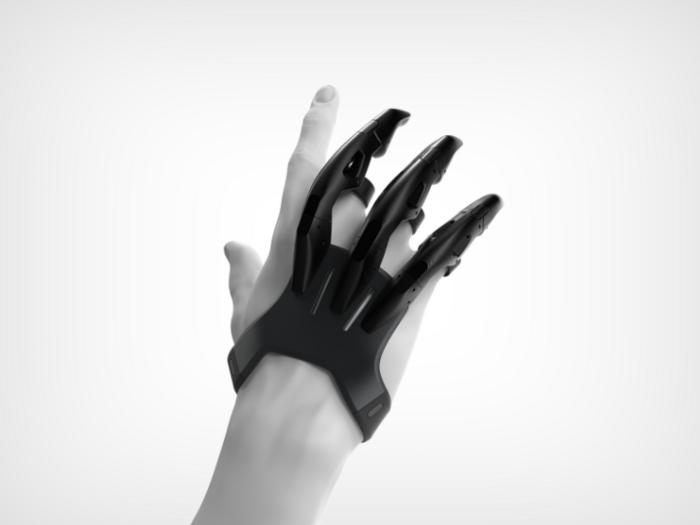A groundbreaking, easy-to-use 3D printable finger prosthesis created by a recent University of Houston graduate could offer amputees a low-cost solution to restore finger functionality. David Edquilang first designed Lunet, which doesn’t need metal fasteners, adhesives or special tools to assemble, as an undergraduate student at the Gerald D. Hines College of Architecture and Design. While standard prostheses can cost thousands of dollars, Edquilang aims to make his design open access on the internet, instead of selling it.

Credit: University of Houston
A groundbreaking, easy-to-use 3D printable finger prosthesis created by a recent University of Houston graduate could offer amputees a low-cost solution to restore finger functionality. David Edquilang first designed Lunet, which doesn’t need metal fasteners, adhesives or special tools to assemble, as an undergraduate student at the Gerald D. Hines College of Architecture and Design. While standard prostheses can cost thousands of dollars, Edquilang aims to make his design open access on the internet, instead of selling it.
“Not every good idea needs to be turned into a business. Sometimes, the best ideas just need to be put out there ,” said Edquilang, who graduated with a Bachelor of Science in Industrial Design last year. “Medical insurance will often not cover the cost of a finger prosthesis, since it is not considered vital enough compared to an arm or leg. Making Lunet available online for free will allow it to help the greatest number of people.”
Edquilang’s mentor at UH was Associate Professor Jeff Feng, co-director of UH’s Industrial Design program. Through a partnership with Harris Health System, Feng learned of a patient who had her fingers amputated due to frostbite. Inspired by working on an upper limb prosthesis Edquilang previously developed with student Niell Gorman, working closely with Professor Feng, Edquilang created prosthetic fingers that returned mobility to the patient, allowing her to pick up objects again.
“It feels great knowing you have the capability to positively impact people’s lives and give them help they otherwise wouldn’t be able to get,” said Edquilang.
Months later, Edquilang was laser focused to make an even better product. Over the course of two weeks, under Feng’s advisory, he designed and tested 60 prototypes before reaching a final design that was more durable, easier to configure and assemble, and had improved functionality.
His “breakthrough” came from a literal break in his design. He intentionally broke one of his prototypes to see where its structural weak point was. It buckled at the distal knuckle, the joint that connects the bones at the fingertips, so he added a linkage that replaced the previously rigid distal knuckle, and an award-winning version of Lunet was born.
Lunet Wins Luminary Award
The prosthetic design garnered Edquilang a 2023 Red Dot: Luminary award, the highest level of recognition accorded at the Red Dot Award: Design Concept. He and Feng took home the coveted accolade at Red Dot’s ceremony last month in Singapore. The winning design was chosen from a list of Best of the Best winners in various categories by Red Dot. Last year, Hyundai Motor Company won the Luminary award.
“Good results come from dedication. Extraordinary results come from experimentation. Incredible results come from a combination of both,” he said upon winning the award.
Lunet also won a 2023 Red Dot: Best of the Best award; two 2023 DNA Paris Design Awards in the Medical and Scientifics category and the Design for People category; won Gold for the 2023 Spark Design Award; was named a 2023 IDEA finalist; is currently a U.S. National Runner Up for the 2023 James Dyson Award and is continuing to compete in the international round of the Dyson award competition.
“David’s recent success in winning the most prestigious design awards across the world is the best manifestation of the unparalleled education and training students experience in our Industrial Design program,” Feng said. “Built upon a belief that every student is a creative individual, the program pedagogy focuses on methods of cultivating innovative minds, which is enforced with rigorous professional training.”
Lunet’s Geometry Inspired its Name
Lunet is made up of two common types of 3D printed plastics: polylactic acid and thermoplastic polyurethane. Each finger is made up of four parts held together by plastic pins. Edquilang describes arcs and circular orbits as the foundation for the motion of the finger mechanism. The geometric basis of the design evoked the idea that the prosthesis orbits around the user’s joints like a moon, or lunet, hence the name.
Another element of Lunet’s uniqueness is that it is nearly impossible to break; other finger prosthetics can be complicated and require many parts.
“The problem with higher mechanical complexity is that these designs are less durable,” Edquilang said. “The more parts you have, the more points of failure. You need to make prosthetic fingers robust and as strong as possible, so it doesn’t break under normal use, yet you want the design to be simple. This was one of the greatest challenges in making Lunet.”
He encourages other design students not to be afraid to experiment and fail because that is often how one can learn to improve the most.
“Where the world has an abundance of problems, designers have an abundance of talent, and we should not be selfish with it,” Edquilang said.




